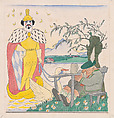Bavarian Royal Dream (Bayrischer Königstraum)
Karl Arnold German
Not on view
Karl Arnold was celebrated for his cartoons and illustrations, which appeared frequently in German journals such as Die Jugend, the Munchener Illustrierte Presse, and most notably, Simplicissimus, a left-leaning German satirical journal begun in 1896 that published leading literary and artistic figures and was known for its often biting political cartoons in which they mocked the Kaiser, the Church, the government, and the military. Arnold's cartoons and political illustrations were distinguished by their skillful compositions and delicate lines, qualities that reflect Arnold's training in drawing and painting. In this watercolor and gouache drawing, he makes reference to the legend of Lohengrin and the story of William Tell. Arnold depicts Lohengrin's arrival in a boat led by swans, but rather than finding a sleeping maiden he discovers an elderly man deep asleep. The inscription that ran underneath the drawing when it was published on the cover of Simplicissimus draws from the first lines of the play "Es lächelt der See, er ladet zum Bade//Der Knabe schlief ein am grünen Gestade," implying that the Bavarian royal figure is a figure from the man's dream. This interpretation is reinforced by the caption for the drawing, printed in the upper right of the magazine's cover: Bayrischer Königstraum, or Bavarian Royal Dream. William Tell was frequently evoked in the period from the 19th century to the beginnings of World War II as symbolizing the fight against tyranny.
Due to rights restrictions, this image cannot be enlarged, viewed at full screen, or downloaded.


